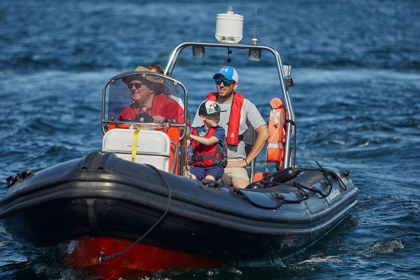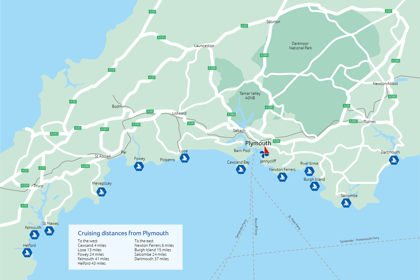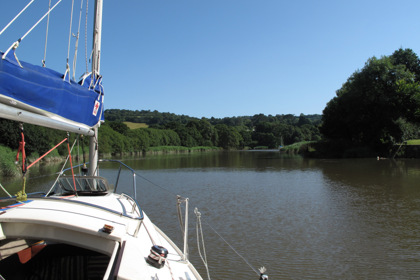
Kingsand, Cawsand Bay
The approach to Kingsand, Cawsand Bay is wide and safe. Sheltered in the prevailing south-westerly winds, this free anchorage can be a wonderful lunchtime or overnight stop. There’s plenty of room to land on the beach where you’ll be rewarded with easy access to a choice of pubs. You’ll even find kayak and SUP hire. Alternatively, it’s a great place for a swim.
On the opposite side of the Sound is Jennycliff, a great anchorage in a northerly or easterly. There's deeper water close in near Withyheadge beacon, and it's generally obstruction-free.

Cellar Bay, River Yealm
This secluded beach is away from the beaten track for landlubbers, which makes it paradise for us sea-goers! There’s plenty of space to anchor off the beach and a few caves to explore once you’re ashore.
The Ship Inn in Noss Mayo is a mile walk away, or just anchor up and enjoy the scenery! A really good spot in an easterly breeze.

Polkerris, St Austell Bay
At high tide, you can tie up at the old harbour wall on this secluded beach where you’ll find a great pub and café on the shoreside. Alternatively, you can anchor just offshore. Join the SW Coast Path and walk up to Gribbin Head to see the famous red and white tower, known locally as “The Stack,” marking the entrance to Fowey Harbour. Alternatively, stay on the beach and hire a SUP to enjoy the calm waters.

Dittisham, River Dart
Venture beyond the main towns of Dartmouth and Kingswear on the River Dart, heading north past Agatha Christie’s house. The cruise beyond the busy towns becomes peaceful with tall woods lining both sides of the river. At Dittisham, it suddenly opens up into a large bay where you’ll find a brilliant pub (The Ferry Boat Inn) and plenty of visitor moorings.

River Fal
Where to start when talking about the Fal and Carrick Roads? On one side of the river, the busy and historical town of Falmouth with Pendennis Castle, a bustling high street, old quays and the maritime museum. On the other, the stunning St Mawes village with the infamous Castle and St Anthony’s Head. Heading further upstream, you’ll find large ships laid up, Pandora’s Inn pub on the edge of Restronguet Creek, beautiful winding inlets and coves, and plenty of wildlife. What’s not to love?

Scilly Isles
Sailing from Plymouth Yacht Haven to the Isles of Scilly is a spectacular adventure, best enjoyed in calm weather along the scenic 94-nautical mile route via the idyllic Helford River. The five inhabited islands each offer something special—St Mary’s lively harbour, Tresco’s tropical gardens and luxury feel, St Martin’s white-sand beaches and seal snorkelling, Bryher’s dramatic coastlines, and St Agnes’ hidden coves and legendary ice cream. While no mooring offers full shelter, spots like St Mary’s Pool, Porthcressa, and New Grimsby Sound are well-equipped, and St Helen’s Pool is the calmest anchorage. It’s wild sailing at its absolute best.
Cruising distance from Plymouth
| Cawsand | 4 n.m. |
| Newton Ferrers | 6 n.m. |
| Looe | 13 n.m. |
| Burgh Island | 15 n.m. |
| Fowey | 24 n.m. |
| Salcombe | 24 n.m. |
| Dartmouth | 37 n.m. |
| Falmouth | 41 n.m. |
| Helford | 43 n.m. |
| Scilly | 94 n.m. |

Plymouth Waterways Small Craft User Guide
Read the Small Craft User Guide from the Plymouth QHM






